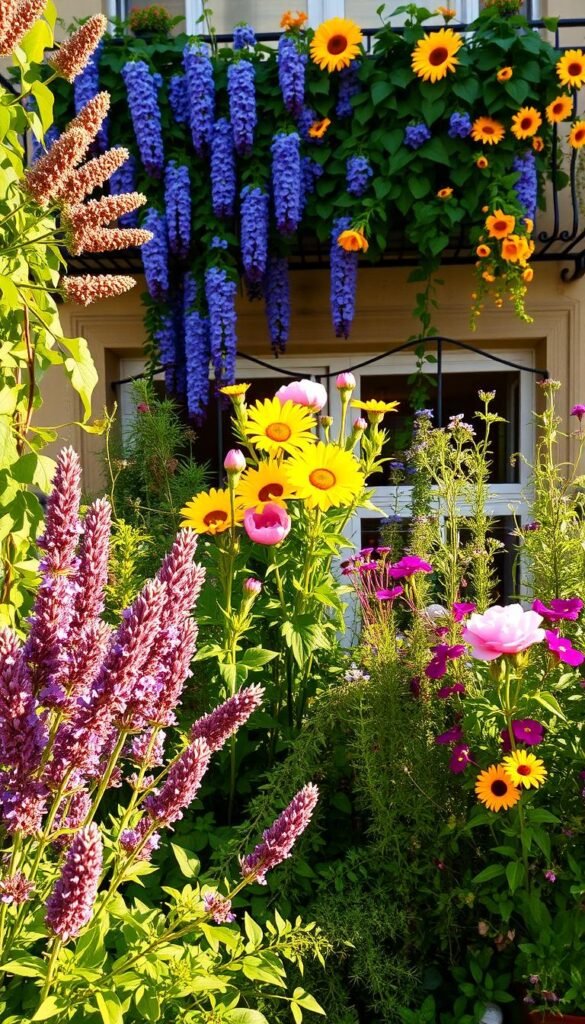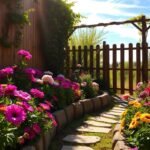Got a small outdoor space that could use some life? Even the tiniest balcony can become a buzzing oasis for pollinators. Urban dwellers often face challenges when trying to support local ecosystems, but container gardening offers a smart solution.
Choosing the right mix of herbs and blooms turns your space into a reliable pit stop for bees. Plants like thyme and basil aren’t just kitchen staples—they’re nectar-rich favorites. Pair them with flowering options such as lavender or marigolds to create bold color contrasts that attract winged visitors.
No yard? No problem. Strategic planters and compact varieties let you maximize every inch. Focus on species with staggered bloom times to ensure pollinators find snacks all season. Bonus: these green additions also freshen up your view and air quality.
Ready to dive deeper? We’ll explore low-maintenance picks, design tricks for small spaces, and how to balance beauty with ecological impact. Let’s turn that underused ledge into a thriving habitat!
Understanding the Benefits of a Bee-Friendly Balcony
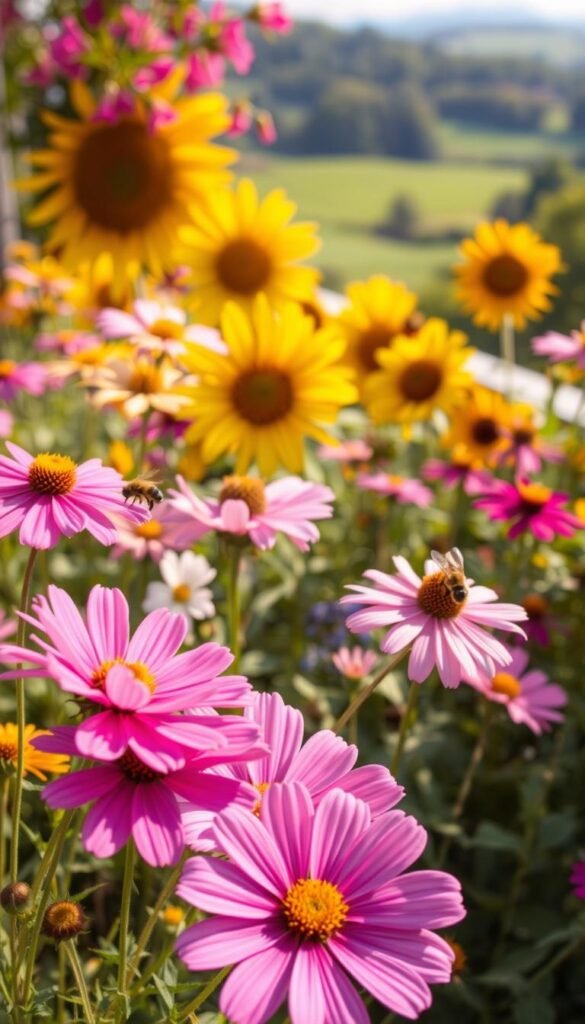
Imagine stepping outside to a lively space where every plant serves a purpose. A buzzing balcony isn’t just pretty—it’s a lifeline for local ecosystems. Let’s break down why these tiny visitors matter and how to keep them coming back.
How Pollinators Enhance Your Urban Garden
Bees work hard to move pollen between plants, which helps your herbs and flowers produce seeds and fruits. Even a few pots can support this process. Without them, urban green spaces struggle to thrive. Think of pollinators as nature’s delivery drivers—they connect plants across concrete jungles.
Seasonal Blooms for Continuous Nectar
Bees need food from early spring through late fall. Start with crocuses or pansies in cooler months, then switch to sunflowers or zinnias in summer. Herbs like chives and basil produce delicate blossoms that offer nectar when other sources fade. Staggering bloom times ensures no bee leaves hungry.
Urban areas often lack diverse habitats, but your plant choices help. Early-spring flowers give bees energy after winter, while late-season blooms prep them for colder months. Bonus: you’ll enjoy rotating colors and scents all year!
Choosing Impactful Flowers for Bees
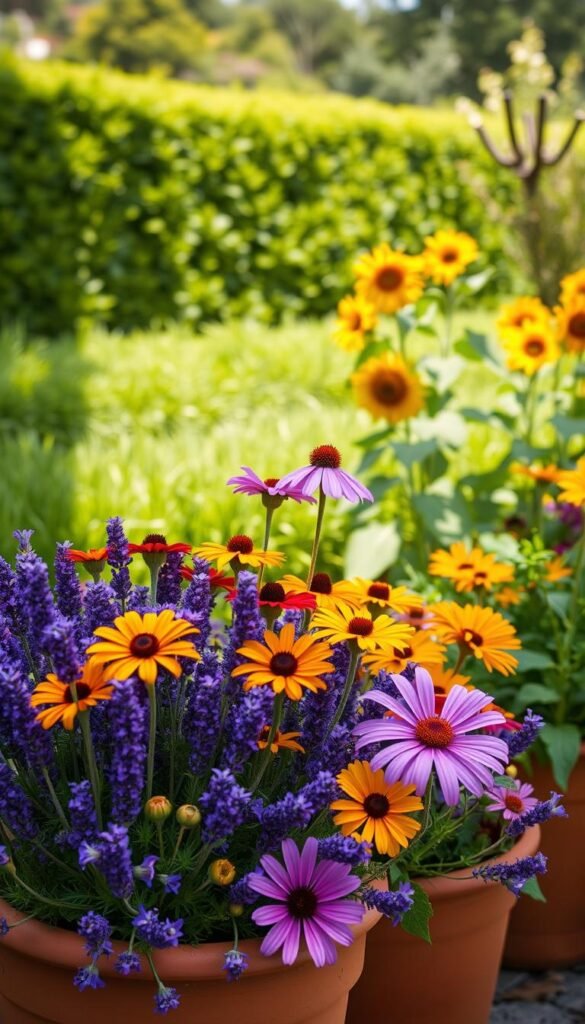
Transform your high-rise retreat into a pollinator paradise with strategic color choices. Bees gravitate toward specific shades, and pairing the right hues with sunlight-friendly varieties ensures your space stays buzzing.
Attracting Bees with Blue and Purple Hues
Bees see ultraviolet light, making violet-toned blossoms like lavender and salvia irresistible. These shades act as neon signs, guiding pollinators to nectar. For compact spaces, try trailing lobelia in hanging pots—its cascading blue flowers thrive in tight areas.
Selecting Vibrant Blossoms for Full Sun Balconies
Sun-loving varieties like marigolds and poppies deliver double rewards: bold visuals and reliable nectar. Aim for 6+ hours of direct sunlight daily. Zinnias are champions here, blooming nonstop with minimal care. Water deeply but let soil dry slightly between sessions to prevent root rot.
| Flower | Sun Needs | Bloom Time |
|---|---|---|
| Marigold | Full sun | Summer-Fall |
| Lavender | Full sun | Late Spring |
| Sunflower | Full sun | Mid-Summer |
Rotate plants seasonally for continuous blooms. Pinch off spent flowers to encourage new growth. With the right mix, you’ll create a living artwork that sustains local bee populations.
Exploring Herb Options That Delight Both You and Bees

What if your spice rack doubled as a bee buffet? Many herbs pull double duty—adding flavor to meals while feeding pollinators. Their aromatic leaves and delicate flowers create a sensory feast that benefits both your kitchen and local ecosystems.
Herbs as Dual-Purpose Plants in Your Garden
Basil’s fragrant white blooms attract bees, though letting it flower can make leaves slightly bitter. Balance by planting extra for pollinators. Thyme thrives in windy spots, offering tiny purple blossoms bees adore. Chives sprout edible purple pom-poms that serve as early-season nectar bars.
Mint spreads quickly, so keep it in pots. Its fuzzy pink flowers draw bees all summer. These plants handle dry soil and partial sun, perfect for urban spaces. Water deeply but infrequently—overwatering drowns roots.
| Herb | Sunlight Needs | Watering Tips | Bloom Time |
|---|---|---|---|
| Basil | 6+ hours | Let soil dry slightly | Mid-Summer |
| Thyme | 4-6 hours | Light moisture | Spring-Fall |
| Chives | 3-5 hours | Consistent dampness | Early Spring |
| Mint | 2-4 hours | Frequent misting | Summer |
Prune regularly to encourage bushier growth and more flowers. Mix varieties in vertical planters to save space. You’ll enjoy fresh garnishes while supporting sustainable gardening—one snip at a time!
Making Your Balcony Bee-Friendly: Flowers & Herb Choices
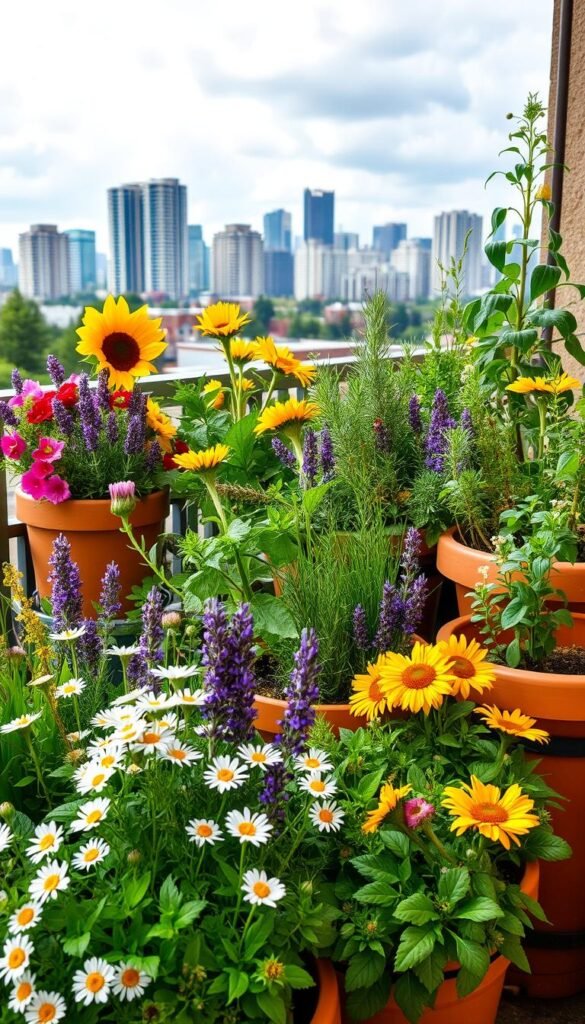
Elevate your urban green space with container gardening tactics that boost growth and support pollinators. Pairing herbs with compact vegetables creates thriving plant communities. Basil shelters tomato roots, while thyme deters pests from nearby blooms—a win-win for your harvest and local bees.
Space-Saving Techniques for Lush Growth
Choose deep pots (12+ inches) for vegetables like patio tomatoes. Shallow containers work for herbs with spreading roots, such as oregano. Ensure drainage holes prevent soggy soil—add gravel at the base. Cluster pots in sunny corners, leaving space for air circulation.
Try vertical stacking: plant trailing nasturtiums beneath upright rosemary. This maximizes light exposure and creates layered nectar sources. Rotate mint or lemon balm every 6 weeks to maintain fresh blooms through summer.
Sunlight-Smart Herb Pairings
Not all herbs need full sun. Chives thrive in morning light, while parsley prefers afternoon shade. Use this table to mix varieties effectively:
| Herb | Container Size | Sunlight | Companion Plant |
|---|---|---|---|
| Greek Basil | 8-inch | 6+ hours | Cherry Tomatoes |
| Lemon Thyme | 10-inch | 4-6 hours | Dwarf Zinnias |
| Curly Parsley | 6-inch | 3-5 hours | Swiss Chard |
Prune herb leaves regularly to encourage flowering. Water in the early morning to reduce evaporation. With these tweaks, you’ll create a buzzing ecosystem that keeps pollinators fed and your meals flavorful!
Designing a Sustainable, All-Season Pollinator Garden
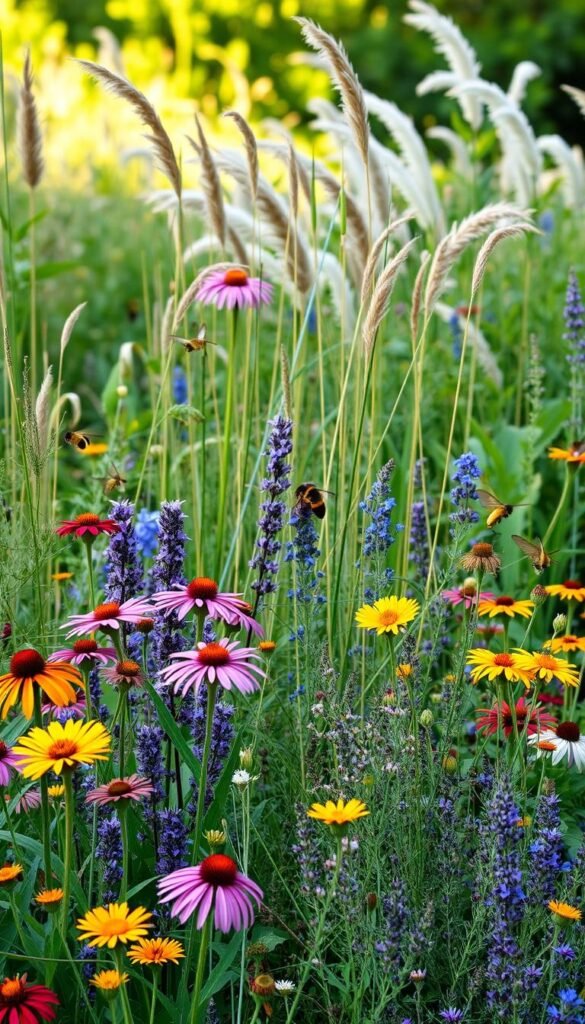
Turn your elevated space into a year-round sanctuary that fuels pollinator populations through every season. Smart design combines sun-loving blooms with shade-tolerant varieties, creating microhabitats where bees and butterflies thrive. Let’s build a resilient ecosystem that adapts to shifting weather while keeping your container gardening efforts low-maintenance.
Balancing Sun and Shade with Versatile Plants
Position tall plants like dwarf sunflowers on your balcony’s sunny side to cast afternoon shade for delicate greens. Pair these with mint or kale in partial shade areas—their flowers provide late-season nectar. Succulents like sedum thrive in full sun while storing water for dry spells.
Use companion planting to boost growth. Leafy vegetables shield soil from evaporation, while herbs like oregano deter pests naturally. Rotate pots seasonally—swap summer marigolds with cold-hardy pansies in fall.
Tactics for Integrating Vegetables, Succulents, and Bee Hotels
Mix edible and ornamental plants for diverse nutrition sources. Peppers attract bees with white flowers, while thyme offers ground cover for solitary species. Add a bee hotel near winter-blooming heather to shelter native pollinators.
Three essentials for winter-ready spaces:
- Use deep pots with drainage holes for root protection
- Layer gravel under soil to prevent waterlogging
- Install a shallow water station with pebbles for safe drinking
Incorporate fall-blooming asters and ornamental cabbage for visual interest after frost. Their seeds feed birds while dormant bee larvae wait for spring. With strategic planning, your balcony becomes a life-sustaining hub across all seasons.
Bloom On: Inspiring Ideas for Your Thriving Bee-Friendly Balcony
Turn your sky-high nook into a buzzing gallery of life and color. Mix trailing lavender with zinnias in vibrant pots—their purple and orange hues act as runway lights for bumblebees. Add mint near seating areas for fresh scent bursts while feeding pollinators.
Layer containers to create depth: tall sunflowers in back, creeping thyme at edges. Tuck butterfly favorites like lantana between herbs for surprise pops of yellow. Rotate seasonal stars—pansies in spring, asters in fall—to keep nectar flowing year-round.
Pair herbs with compact veggies like patio tomatoes. Their blooms attract bees while yielding snacks for you. Refresh plantings every few months; try new varieties like lemon basil or chocolate cosmos for visual drama.
Add personality with painted pots or bee-themed decor. A shallow dish with stones makes a stylish water station. Remember—your choices matter. Even small spaces become vital food hubs when packed with diverse, blooming life.

